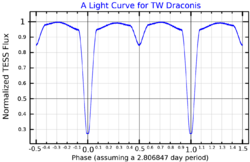HD 139319
Topic: Astronomy
 From HandWiki - Reading time: 3 min
From HandWiki - Reading time: 3 min
Coordinates: ![]() 15h 33m 51.0571s, +63° 54′ 25.6950″
15h 33m 51.0571s, +63° 54′ 25.6950″
| Observation data Equinox J2000.0]] (ICRS) | |
|---|---|
| Constellation | Draco |
| Right ascension | 15h 33m 51.0571s |
| Declination | +63° 54′ 25.6950″ |
| Apparent magnitude (V) | 7.46[2] |
| Characteristics | |
| HD 139319A | |
| Spectral type | A8V+K0III [3] |
| Apparent magnitude (g) | 7.39[4] |
| HD 139319B | |
| Spectral type | F7V |
| Apparent magnitude (g) | 9.65[5] |
| Astrometry | |
| HD 139319A | |
| Proper motion (μ) | RA: 11.44±0.03[4] mas/yr Dec.: 22.39±0.02[4] mas/yr |
| Parallax (π) | 6.0571 ± 0.0179[4] mas |
| Distance | 538 ± 2 ly (165.1 ± 0.5 pc) |
| HD 139319B | |
| Radial velocity (Rv) | 1.6±0.7[5] km/s |
| Proper motion (μ) | RA: 12.09±0.02 mas/yr Dec.: 21.278±0.018 mas/yr |
| Parallax (π) | 6.0345 ± 0.0160[5] mas |
| Distance | 540 ± 1 ly (165.7 ± 0.4 pc) |
| Orbit[6] | |
| Primary | TW Draconis A |
| Companion | TW Draconis B |
| Period (P) | 2.8068491 d |
| Semi-major axis (a) | 0.057 AU |
| Inclination (i) | 86.8° |
| Semi-amplitude (K1) (primary) | 64.05 km/s |
| Semi-amplitude (K2) (secondary) | 150 km/s |
| Details[7] | |
| TW Draconis A | |
| Mass | 2.16±0.11 M☉ |
| Radius | 2.64±0.04 R☉ |
| Surface gravity (log g) | 3.928±0.026 cgs |
| Temperature | 7815±92 K |
| TW Draconis B | |
| Mass | 0.93±0.05 M☉ |
| Radius | 3.66±0.06 R☉ |
| Surface gravity (log g) | 3.314±0.026 cgs |
| Temperature | 4442±32 K |
| Other designations | |
BD+64 1077, HIP 76196, 2MASS J15335104+6354257, GSC 04184-00061 | |
| HD 139319A: TW Draconis, TYC 4184-61-1, Gaia DR2 1640708022815757568 | |
| HD 139319B: TYC 4184-61-2, Gaia DR2 1640708022815757824 | |
| Database references | |
| SIMBAD | data |
HD 139319 is a ternary system composed of the binary Algol variable star known as TW Draconis, and a main-sequence companion star at a separation of 3 arcseconds.[6] The system lies in the constellation of Draco about 540 light years away.
System
The primary star is an eclipsing, semi-detached binary, the brighter component of which is a pulsating star of Delta Scuti type. Its pulsation frequency is 17.99 cycles per day.[3] Mass transfer between stars is ongoing in the system[8] with a transfer rate of 6.8×10−7M☉/year. The 2.8 day period of the Algol binary is cyclically variable with a period 116.04 years, possibly due to gravitational influence of the distant companion HD 139319B. Another three stars in the system are suspected.[6]
References
- ↑ "MAST: Barbara A. Mikulski Archive for Space Telescopes". Space Telescope Science Institute. https://mast.stsci.edu/portal/Mashup/Clients/Mast/Portal.html.
- ↑ "TW Dra". SIMBAD. Centre de données astronomiques de Strasbourg. http://simbad.u-strasbg.fr/simbad/sim-basic?Ident=TW+Dra.
- ↑ 3.0 3.1 Kim, S.-L.; Lee, J. W.; Kwon, S.-G.; Youn, J.-H.; Mkrtichian, D. E.; Kim, C. (2003), "Search for A–F Spectral type pulsating components in Algol-type eclipsing binary systems", Astronomy & Astrophysics 405: 231–236, doi:10.1051/0004-6361:20030630, Bibcode: 2003A&A...405..231K
- ↑ 4.0 4.1 4.2 Brown, A. G. A. (2021). "Gaia Early Data Release 3: Summary of the contents and survey properties". Astronomy & Astrophysics 649: A1. doi:10.1051/0004-6361/202039657. Bibcode: 2021A&A...649A...1G. Gaia EDR3 record for this source at VizieR.
- ↑ 5.0 5.1 5.2 Brown, A. G. A. (2021). "Gaia Early Data Release 3: Summary of the contents and survey properties". Astronomy & Astrophysics 649: A1. doi:10.1051/0004-6361/202039657. Bibcode: 2021A&A...649A...1G. Gaia EDR3 record for this source at VizieR.
- ↑ 6.0 6.1 6.2 Liao, Wen-Ping; Qian, Sheng-Bang; Zejda, Miloslav; Zhu, Li-Ying; Li, Lin-Jia (2016), "Lunar-based Ultraviolet Telescope study of the well-known Algol-type binary TW Dra", Research in Astronomy and Astrophysics 16 (6): 009, doi:10.1088/1674-4527/16/6/094, Bibcode: 2016RAA....16...94L
- ↑ Bozic, H.; Nemravova, J.; Harmanec, P. (2013), "Standard UBV photometry and improved physical properties of TW Dra", Information Bulletin on Variable Stars 6086: 1, Bibcode: 2013IBVS.6086....1B
- ↑ Norton, A. J.; Lohr, M. E.; Smalley, B.; Wheatley, P. J.; West, R. G. (2016), "SuperWASP discovery and SALT confirmation of a semi-detached eclipsing binary that contains aδScuti star", Astronomy & Astrophysics 587: A54, doi:10.1051/0004-6361/201526881, Bibcode: 2016A&A...587A..54N
 |
 KSF
KSF
